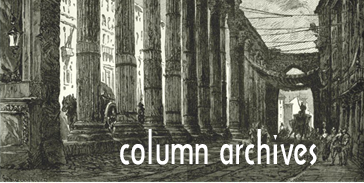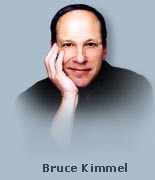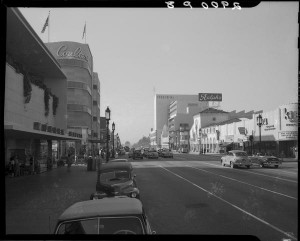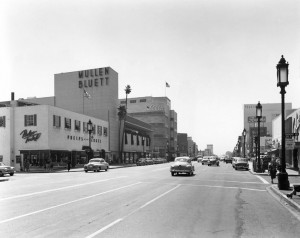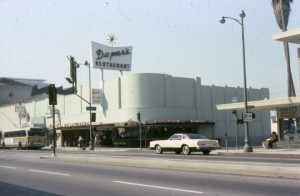Well, dear readers, as you know, I’m a Los Angeles native and I’ve written about our fair city in almost every one of my books, sometimes the LA of old (the Kritzer books, one story in How To Write a Dirty Book and Other Stories), sometimes the LA of new (the Adriana Hofstetter books, parts of Writer’s Block). I don’t much care for the new, but I loved the old. So, anytime I find a movie from long ago and it takes place here I revel in it, whether the film is good or bad, especially if there are location shots. And as it happens, with a whole slew of crime films and films noir, there are a LOT of films with incredible location shots. Every time I see a movie listed somewhere and it’s from the late 1940s or the 1950s and it’s a crime or noir I immediately check it out to see where it takes place. Such was the case last evening when I went to the Flix of Net and was seeing what they’d recommended – based on a couple of movies in my list, they’d recommended some older films, including a few crime films and noirs, one of which had the nifty title of Down Three Dark Streets. Well, that’s too good a title to resist – that just reeks of noir, it drips of noir. So, I began watching it – it’s one of those typical early 50s things with narration and stately FBI music done in a semi-documentary way – there were many, many films that used that style – some good, some bad, and some ugly. This one begins with a crook on the lam pulling into some backwoods gas station run by a very young William Schallert. Schallert tries to alert the FBI that this most wanted man is at his station but the man shoots him and goes on his way, heading towards – be still my heart – Los Angeles.
We then get the conceit of the story. That an FBI man (Kenneth Tobey) is working on three separate cases. He’s killed and his supervisor (Broderick Crawford) thinks the killer is tied into one of these cases. And so he goes down the dark streets of the three cases and ultimately finds the murderer. It’s a good cast – also includes Ruth Roman, Marisa Pavan, a very young Claude Akins, Max Showalter and other fine character actors. It’s competently directed by Arnold Laven, and well photographed by Joe Biroc. Now, here’s where things get interesting: It’s based on a novel called Case File: FBI by The Gordons, Mildred and Gordon, who wrote several excellent crime books, including Operation Terror and Undercover Cat. The latter became the Disney film, That Darn Cat, and the former became the Blake Edwards film, Experiment in Terror. One of the three stories in Down Three Dark Streets is an extortion plot and would become the basis of Operation Terror (Experiment in Terror). Broderick Crawford plays Agent John Ripley just as Glenn Ford plays Agent John Ripley in Experiment in Terror.
Anyway, as I was hoping, the film is chockfull of great location shots, some I knew right away, some I didn’t. My favorite was the front of Ohrbach’s department store on Wilshire Blvd. circa 1954. Just a few blocks down the street and right around that time, my father opened a Miracle Mile branch of his restaurant, the Kiru. The story I’ve always been told was that it failed because it was a dinner restaurant on a street that had no nightlife – the Miracle Mile was a daytime street. The story then went that the restaurant was a disaster, closed, and that Van de Kamp’s put in their coffee shop and the rest is history – it was a hugely popular place for decades. But Google turned out to be my friend and this story turns out to not be quite what I was told all these years. Because, as it turns out, the Kiru he opened in the Miracle Mile WAS a coffee shop and WAS open during the day. I have now looked at so many photographs of that era and that part of Wilshire and my head is swimming. To my eyeballs it would appear that the Kiru Coffee Shop was on the northwest corner of Wilshire and Ridgely, directly across from Coulter’s Department Store, which was on the southwest corner. To the north of Coulter’s on the southeast side of Wilshire and Ridgely was Mullen and Bluett, another department store. Well, take a look at what I found and see for yourself.
Can you believe I found that photo? Now, Ohrbach’s was down by that Prudential building a couple of blocks away, at the corner of Wilshire and Masselin, on the north side of the street. And on the northeast corner of the intersection was Van de Kamp’s. And from photos I’ve seen, it looks like Van de Kamp’s was built in 1951, which means my father’s restaurant may have been a year or two prior to that, looking at the cars. But then there’s this interesting photo of Mullen and Bluett on the left and you can see where Coulter’s is on the same side of the street just to the west. But the perspective seems to be all squashed, perhaps a long lens. But, if you look carefully, you’ll see across from Coulter’s what looks to be a Du-Par’s where the Kiru was.
And sure enough, here’s a 1978 photo of Du-Par’s at the corner of Wilshire and Ridgely, clearly the same building as the Kiru.
Now, if you look at the black-and-white photos, the cars all seem from the same era – can anyone figure out the year from those cars? Because where my mind is going is that my father opened the Kiru Coffee Shop, it failed, and then Du-Par’s took it over and voila, a success, even though it was only two and a half to three blocks east of Van de Kamp’s. But another site says the Du-Par’s didn’t go in there until the mid-1950s but those cars don’t lie. There is nothing that resembles a mid-1950s automobile on that street. So, I’m hoping one of you dear readers will be good at figuring out car years and we can solve the mystery, even though I think the time between the Kiru and Du-Par’s will be relatively short.
Well,that turned into something wholly other, didn’t it? And now it’s going on one-thirty in the morning. Anyway, in the film I was discussing, you get that great shot of Ohrbach’s, some incredible downtown footage, including a 1954 view of the LA subway – yes, the LA subway. There are many other neat locations, but none neater than Beachwood Canyon when there were still empty lots all over the place, leading right up to where the finale of the film is set – the Hollywood sign. And you see the incredible view of the city that used to be LA – with virtually no tall buildings in sight.
Prior to watching that, I’d gotten about eight hours of sleep. I did some writing, then went and had an extra lean pastrami – the Sky High (which wasn’t all THAT Sky High) with cole slaw and 1000-Island dressing. It was pretty decent, but here’s the problem – the sandwich cost (extra lean is extra dough) $20. I couldn’t believe it, really. Sorry, that’s just too much for a small sandwich with no fries or onion rings. In fact, it’s obscene. Add to that the annoyance that all my usual booths were taken – at NOON – when no one is EVER there on a weekday, and I think you might imagine that I was irked.
After that I came home, did some more writing, did a jog, and then sat on my couch like so much fish, watched one episode of The Honeymooners (really funny – the Christmas episode) and then Down Three Dark Streets.
Today, I have a lot of busy work to do, I’ll eat, hopefully I’ll pick up some packages and then relax.
Tomorrow I have a lunch meeting, then I’m seeing a cabaret show. Thursday or Friday will be a work session with Sami, I’m seeing a show, I think, over the weekend, and then we begin rehearsals for Welcome to My World.
Well, dear readers, I must take the day, I must do the things I do, I must, for example, do some busy work, eat, hopefully pick up packages, and relax. Today’s topic of discussion: What were/are your favorite coffee shops, wherever you may have lived? Let’s have loads of lovely postings, shall we, whilst I hit the road to dreamland, happy to have finally at least begun solving the mystery of where the Kiru Coffee Shop was and when it was there and how long.

